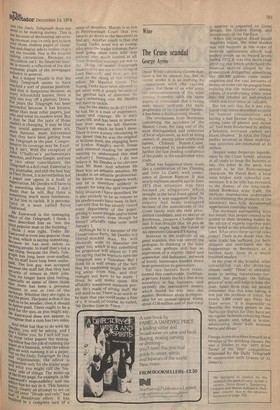Wine
The Cruse scandal
George Ayres
Oscar Wilde's drinking classes may, have a lot to answer for, but in recent weeks it is as nothing by comparison with the tasting classes. For those of us who greet the pronouncements of the wine writing fraternity with the same degree of enthusiasm that a racing man would welcome the daily prophecies of his favourite tipster, it has been a disillusioning month.
The revelations from Bordeaux concerning the activities of the Maison Cruse, for long one of the most distinguished and respected of local negociants, as well as being owners of, among other celebrated names, Chateau Pontet-Canet, have conspired to undermine still further the fast eroding confidence of the public in the established wine trade.
What has happened there reads like a combination of Ian Fleming and John Le Carr, with undertones of Damon Runyan. It was nearly eighteen months ago in June 1973 that attention was first focused on allegations which brought in the local fraud squad. At the time it was suggested that the enquiry had been instigated because of the associations of the Cruse family with the then presidential candidate, and ex-mayor of Bordeaux, Jacques Chaban-Delmas. It was thought that `un peu de scandale' might help the cause of his opponent Giscard d'Estaing.
However in the tradition of all great scandals, this was merely the prologue. In thinking of the wine trade, one perhaps still has an impression of a slightly faded and somewhat old-fashioned network of family businesses handed down from generation to generation.
Yet two factors have transformed this comfortable, traditional picture. Firstly the fact that wine nowadays is big business, and secondly the speculative money which found its way into the market. Bordeaux alone is responsible for an annual output worth about £150 million and of that total
a quarter is exported to Great Britain, the United States, and increasingly to the Far East.
When the original fraud squad inquiries began, the wine market was still buoyant in the wake of feverish speculation which had pushed prices up to record levels during 1972. It was this more than anything else which underlined the financial motives alleged by the prosecution. Altogether, something like 600,000 gallons came under suspicion and the vast amounts of money at stake can be gauged from realising that the 'miracle', among others, of transforming white wine into red created an end-product which was four times as valuable.
But not only this, for it was also stated that wines described as unfit for human consumption and having a bad flavour including "a strong taste of phenol and motor oil" had been deodorised by adding ebetonite, activated carbon and blood albumen." In total, the illegal profits involved in these multifarious activities are estimated at El Despite some desperate legerdemain by the Cruse family, anxious at all costs to keep the hunters at bay, the joker in the pack was proved to be the , Runyonesque character, Mr Pierre Bert, a local wine broker with colourful connections. It is he who has revealed, to the dismay of the long-established Bordeaux wine trade, the Intricate manoeuvres undertaken in transforming the products of the laboratory into fully documented appellation controlee wines.
The mystique surrounding wine has meant that people tended to be guided in their drinking habits by the advice of experts together with their belief in the infallibility of the label. What price these sacred cows today? There is no doubt that the wine trade has suffered, for both shippers and merchants see the happenings in Bordeaux as a further body blow in a much troubled market. "
In the year of the Scandal, what consolation can the drinking classes seek? There is certainly , none in seeing reputations tarnished, but perhaps the falling prices of wine will help to ease the pain. Apart from that, we should remember that this wine faking is not just the problem of today, for nearly 2,000 years ago Pliny the Elder wrote, "It is impossible to describe the wines grown in the Narbonne district for they have set up regular factories colouring them with smoke and, what is worse, adulterating, them with noxious herbs and drugs."
George Ayres describes himself as a member of the drinking classes. He was a finalist in the '1973 Wine Taster of the Year' competition organised by the Daily Telegraph in conjunction with Grants of St James's.




















 Previous page
Previous page